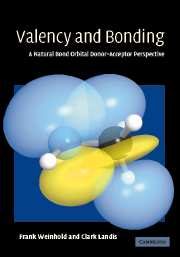Book contents
- Frontmatter
- Contents
- Preface
- 1 Introduction and theoretical background
- 2 Electrostatic and ionic bonding
- 3 Molecular bonding in s/p-block elements
- 4 Molecular bonding in the d-block elements
- 5 Supramolecular bonding
- Appendix A Methods and basis sets
- Appendix B Chemical periodicity
- Appendix C Units
- Chemical-species index
- Author index
- Subject index
Appendix A - Methods and basis sets
Published online by Cambridge University Press: 04 December 2009
- Frontmatter
- Contents
- Preface
- 1 Introduction and theoretical background
- 2 Electrostatic and ionic bonding
- 3 Molecular bonding in s/p-block elements
- 4 Molecular bonding in the d-block elements
- 5 Supramolecular bonding
- Appendix A Methods and basis sets
- Appendix B Chemical periodicity
- Appendix C Units
- Chemical-species index
- Author index
- Subject index
Summary
A quantum-mechanical calculational model can be uniquely specified by identifying (i) the method of approximation and (ii) the orbital basis set that underlies the model. The model is conventionally specified by a keyword label of the form method/basis, where method and basis are suitable identifying abbreviations or acronyms. Simple examples are “RHF/6-31G*” (for the RHF restricted Hartree–Fock method and the 6-31G* basis set) or “B3LYP/6-311 + +G**” (for the B3LYP hybrid density functional method and the 6-311 + +G** basis set). In this appendix we briefly describe the principal method and basis types that are now well established in the literature, particularly as implemented in the Gaussian program. Consult notes 1 and 2 for background information and original references.
Methods
Quantum-mechanical approximation methods can be classified into three generic types: (1) variational, (2) perturbative, and (3) density functional. The first two can be systematically improved toward exactness, but a systematic correction procedure is generally lacking in the third case.
Variational methods
Variational approximation methods are identified by the form of the variational trial function, particularly by the number and types of Slater determinants.
The simplest approximation corresponds to a single-determinant wavefunction. The best possible approximation of this type is the Hartree–Fock (HF) molecular-orbital determinant. The HF wavefunction is constructed from the minimal number of occupied MOs (i.e., N/2 for an N-electron closed-shell system), each approximated as a variational linear combination of the chosen set of basis functions (vide infra).
Information
- Type
- Chapter
- Information
- Valency and BondingA Natural Bond Orbital Donor-Acceptor Perspective, pp. 710 - 714Publisher: Cambridge University PressPrint publication year: 2005
